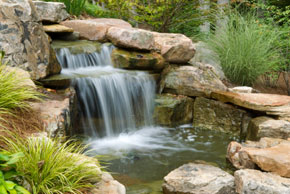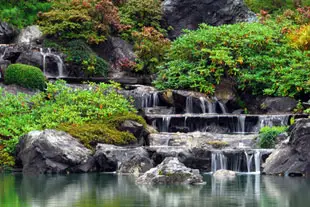Guide to Pond Waterfall Design and Installation
Pond waterfalls are some of the most relaxing and elegant features that one can add to their fish pond or water garden. These features are easy to create and have the added benefit as acting as a type of aerator. One can truly let their creativity shine in this endeavor and, provided that one chooses the right supplies for the task, the waterfall feature may well prove to be the standout aspect of their pond.
Supplies
The most important supplies needed for a waterfall are a pump and a length of hose. There are two basic pump styles from which one can choose: submerged and above water. The submerged varieties offer reliable service and, because they are underwater, their noise levels are minimal. The above water varieties are easier to service but are noisier.

If one is using a submerged pump for their garden pond waterfall, place it on a milk crate or another porous surface under the waterline so that, in the event that something goes wrong preventing the pumped water from returning to the pond, the pump does not pump all of the water out of the pond. The magnetic drive pumps on the market have several advantages over the other types. Principally, if the engine should fail there are no coolants or oils which will leak into the water.
The pump must be adequate for the waterfall you aim to create. If the pond will have a single shared pump that will also pump the waterfall and one intends to circulate all the pumped water through the waterfall, then it should circulate at least half the volume of the pond once per hour or at least the entire volume if it's a koi pond. Pumps will be rated in gallons per hour, abbreviated GPH. To determine the amount of water use the pond volume calculator, and then use the pond pump calculator to work out many GPH (gallons per hour) the pump must be able to pump. The GPH of the pump should be a bit above that figure.
If the waterfall will be pumped by a dedicated pump then that pump should be capable of pumping the required GPH desired. The size of waterfall is important. For every one inch of spillway, 150 gallons of water will pass over every hour. Therefore, for a 4 inch spillway, one should anticipate that 600 gallons of water will go over the feature every hour, a pump with a rating of at least 600 GPH is required.
Also keep in mind that the pond pump will be rated as able to lift a given amount of water at different elevations, normally a chart displays the GPH rating at different height levels. The higher the water is pumped the lower the GPH will be. This is known as "static head" and is a very important consideration depending on the waterfall height. Therefore if the highest point of the waterfall is 2 feet above the pond surface and a flow of 600 GPH is required, check the pumps specifications to make sure that it can pump 600 GPH to a height of 2 feet.
Additionally for every 10 feet of hose, there is the approximate equivalent work of 1 foot of elevation for the pump due to friction; this will vary depending on the thickness of the hose and other factors. This is known as the "friction head". Gardening stores will have charts that make this conversion work very easy for the products they sell.
There are pumps which are designed specifically for waterfall pond features and these are, by far, the best choices. The most powerful pumps will be rated in horsepower. This can be converted to gallons per hour by using the supply house's charts.
One will need electricity to power the pump, of course. The outlet used for this should be a minimum of 6 feet away from the pond and absolutely must have a ground fault interrupter installed as a safety feature. This ensures that the circuit will be broken if water somehow reaches the outlet or if the extension cord becomes compromised.
Building Materials
Creating the actual waterfall is probably the most enjoyable part of this task. One can use pieces of slate or stone to create the spillway and pile rocks around the edges to control the flow of the water. This is really an opportunity to let one's imagination run wild. Remember that a very large spillway will require a very large pump, so be sensible when creating this feature.
Most individuals choose to create the spillway at the pond's edge. Simply place a piece of stone over the lip of the pond and secure it in place with dirt or other stones. One may also choose to have an open artificial river that leads to the waterfall though this makes the task much more complex and requires a more powerful pump.
One can also place plants at the edges of the waterfall to conceal the mechanics used and to add a nice natural touch. Adding some aquatic plants next to the pond waterfall also adds a nice aesthetic feature.
One will need to conceal the hose for the most pleasant look. This can be done with rocks and dirt or, if the owner chooses, the hose leading to the waterfall can be buried completely in the Earth. Remember that a buried hose is harder to maintain if something goes wrong. This choice is entirely up to the gardener. Keep the gradient as gentle as possible and keep the hose length as short as possible to avoid having to purchase a very expensive and powerful pump!
The spot where the hose exits the water can be concealed with landscaping rocks. To make it is an unintrusive as possible, place the hose in an area away from where people generally view the pond. One can encourage people to stay away from this hardware simply by putting seating fixtures and other decorations on the side of the pond farthest from the waterfall.

Some individuals like to add lighting to make it more dramatic at night. Some carefully positioned pond lights can be a nice touch, though some look for a more natural setting in pond waterfalls. Either way, the sound of running water is psychologically very relaxing and waterfalls create a nice white noise that can block out the typical mechanical noises that characterize our modern environment. For the sound feature, remember that a larger spillway and more water volume will create a more noticeable sound. A higher plunge into the pond on the part of the water will also create more sound.
Make certain that the construction of the pond waterfall features are stable and secure before turning on the pump. The spillway should be in no danger of falling into the water and the hose should be stable and not under any tension which may wrench it from its position. The landscaping rocks used should present no danger of piercing or kinking the hose and there should be no water leaking out of the fixture, of course. Once all of this is taken care of, turn on the waterfall and enjoy the results of one's labor at this project!

